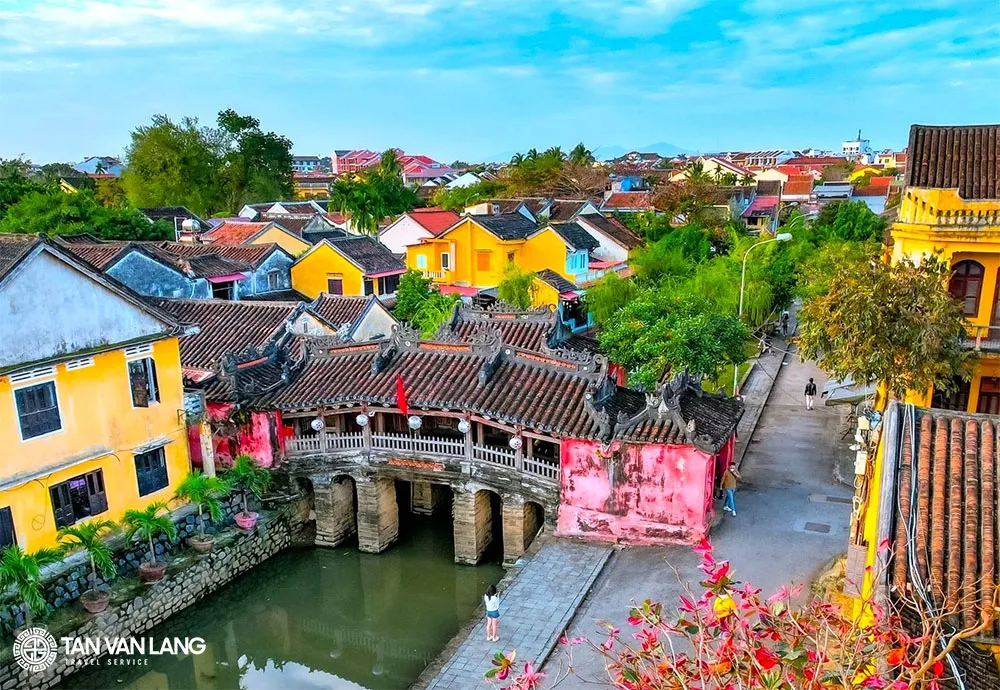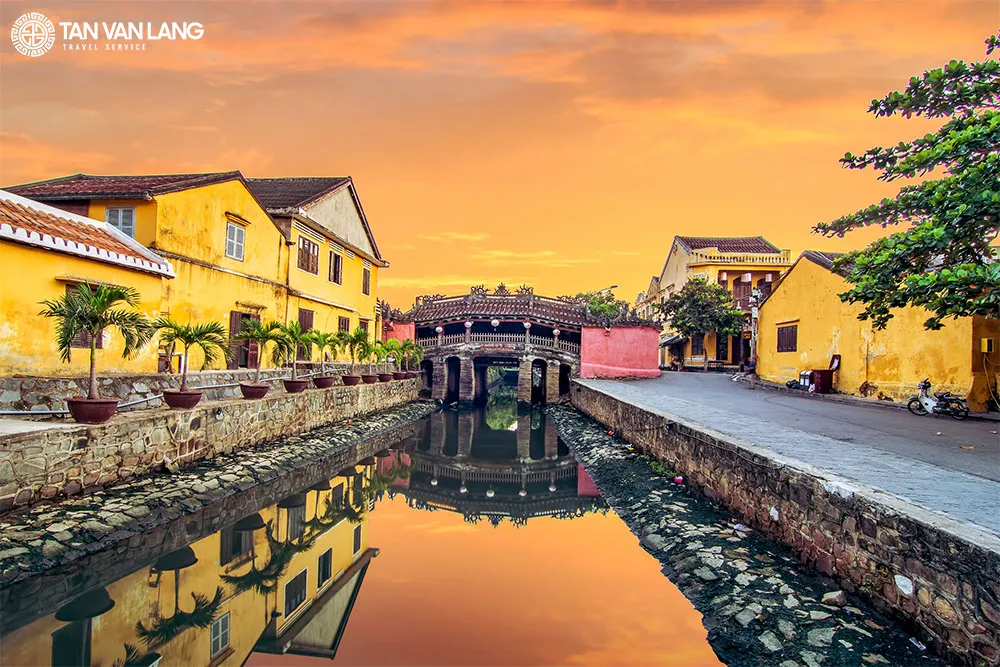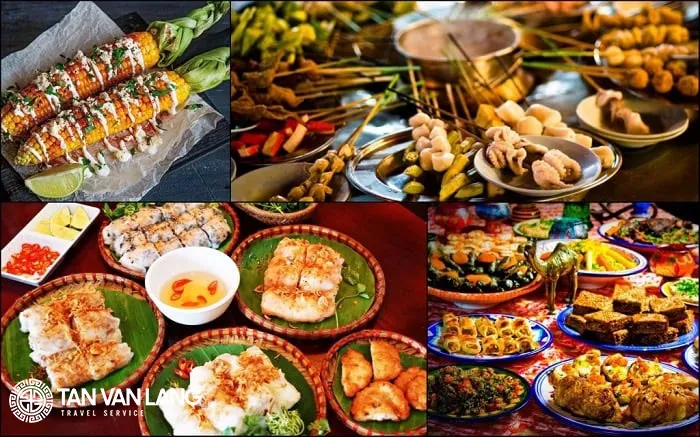Hoi An Vietnam travel is a must for anyone visiting the Central part of Vietnam. This ancient town offers charming lantern-lit streets, historic houses, iconic landmarks like the Japanese Covered Bridge, and delicious local food. Let’s explore through this article of Tan Van Lang!
Exploring the Heart of Hoi An Ancient Town: A Step Back in Time
Hoi An Ancient Town, nestled along the Thu Bon River in central Vietnam, is a rare jewel where time seems to stand still. A designated UNESCO World Heritage Site since 1999, this former Southeast Asian trading port flourished between the 15th and 19th centuries. Its strategic location made it a melting pot for Chinese, Japanese, and European influences, evident in the unique blend of architecture and culture.
Today, Hoi An remains a beautifully preserved town, with mustard-yellow walls, vine-covered alleyways, and traditional wooden houses that take visitors on a nostalgic journey through Vietnam’s past.
The Iconic Japanese Covered Bridge: A Symbol of Hoi An
- Built in the early 1600s by the Japanese community to connect them with the Chinese quarters across the river, the Japanese Covered Bridge (Chùa Cầu) is perhaps the most recognized landmark in Hoi An.
- Its weathered wooden beams, intricately carved details, and the small pagoda nestled within its length stand as a testament to the enduring friendship and cultural fusion between the Japanese and Vietnamese people.
Its graceful silhouette is incredibly captivating at night when lit by warm yellow lights. - A visit here offers beautiful photos and insight into Hoi An’s historical commitment to cross-cultural connection.
Wandering Through the Lantern-Lit Streets: An Evening Spectacle
- As dusk descends upon Hoi An, the ancient town transforms into a magical spectacle of light and color. Thousands of silk lanterns, in every imaginable shape and hue, illuminate the streets, casting a warm and enchanting glow on the centuries-old architecture.
- Strolling along the lantern-lit Thu Bon River or meandering through the bustling night market becomes an unforgettable experience, where the gentle breeze carries the soft murmur of conversations and the tantalizing aromas of local cuisine.
- This evening spectacle is a true feast for the senses, painting a picture of Hoi An’s enduring charm.
Chinese Assembly Halls: Glimpses into Hoi An’s Trading History
The prosperity of Hoi An as a major trading port attracted merchants from various parts of Asia, and the Chinese community played a significant role in its development. Their legacy is beautifully preserved in the numerous Chinese Assembly Halls scattered throughout the town.
These ornate structures served as meeting places, temples, and community centers for people from different provinces of China, each showcasing unique architectural styles and intricate decorations that reflect their regional origins.
Quang Dong Assembly Hall
The Quang Dong (Cantonese) Assembly Hall, with its grand entrance and elaborately decorated interiors, highlights the craftsmanship and cultural traditions of the Cantonese merchants who settled in Hoi An.
Fujian Assembly Hall
The Fujian (Phuc Kien) Assembly Hall is arguably the most visually stunning, dedicated to the goddess of the sea, Thien Hau. Its intricate carvings, vibrant colors, and serene courtyards offer a fascinating glimpse into the beliefs and artistic flair of the Fujianese community.
Chaozhou Assembly Hall
The Chaozhou Assembly Hall is known for its exquisite wood carvings and its dedication to the deity Phuc Ba, showcasing the distinct cultural heritage of the Chaozhou people.
Ancient Houses: Preserving Centuries of Heritage
Beyond the assembly halls, Hoi An is also home to numerous well-preserved ancient houses, offering a more intimate look into the lives of the families who resided here centuries ago. These architectural gems, often passed down through generations, showcase a unique blend of Vietnamese, Chinese, and Japanese influences in their design and furnishings.
Tan Ky Old House
The Tan Ky Old House, one of the most famous, has been remarkably preserved for over 200 years. Its intricate carvings and the symbolic “heaven-earth-man” design reflect the philosophical beliefs of its former inhabitants.
Phung Hung Old House
The Phung Hung Old House, with its distinctive two-story structure and a blend of architectural styles, once belonged to a wealthy Vietnamese merchant family and provides insight into the town’s trading past.
Quan Thang Old House
The Quan Thang Old House, with its beautiful Chinese-style architecture and intricate details, offers another perspective on the diverse cultural influences that shaped Hoi An.
Hoi An Market: A Vibrant Hub of Local Life and Commerce
- In contrast to the serene temples and historic houses, the Hoi An Market is a vibrant and bustling hub of local life and commerce.
- Situated along the Thu Bon River, this lively market terms with vendors selling everything from fresh produce and spices to colorful silks and handcrafted souvenirs.
- It’s a fantastic place to immerse yourself in the local culture, sample delicious street food, and witness the daily rhythm of life in this enchanting ancient town.
>>> Read more: Top 10 Must-Visit Vietnam Travel Locations for an Unforgettable Trip
Must-Do Experiences in Hoi An: Beyond the Ancient Streets
While the lantern-lit charm of the Ancient Town is undeniable, Hoi An offers a wealth of experiences that extend beyond its historic core. From getting custom-made clothing to savoring the flavors of local cuisine and escaping to pristine beaches, there’s something to captivate every traveler. Venture beyond the ancient streets and discover these must-do experiences in Hoi An.
Tailor Shopping: Getting bespoke clothing made
- Hoi An is renowned as a tailoring paradise, attracting visitors from around the globe seeking high-quality, custom-made clothing at incredibly reasonable prices.
- Numerous tailor shops line the streets, offering an extensive array of fabrics, styles, and skilled craftsmanship. Whether you desire a perfectly fitted suit, a flowing silk dress, or comfortable everyday wear, the tailors of Hoi An can bring your sartorial visions to life in a matter of days, often even within 24 hours.
- The experience of being measured, selecting your fabric, and witnessing your bespoke garment take shape is a unique and rewarding part of the Hoi An experience.
Indulging in a Hoi An Cooking Class: Mastering local flavors
- Vietnamese cuisine is celebrated worldwide for its fresh ingredients, vibrant flavors, and delicate balance. In Hoi An, taking a cooking class is a fantastic way to delve deeper into the local culinary traditions and learn the secrets behind iconic dishes.
- Many cooking schools offer immersive experiences, starting with a visit to the local market to select fresh produce and seafood, followed by hands-on instruction in preparing regional specialties like Cao Lau, sweet soup, Chicken rice,… Not only will you gain valuable cooking skills, but you’ll also savor the delicious fruits of your labor.
Relaxing on Hoi An’s Beautiful Beaches
Just a short and easy ride from the Ancient Town lies a stretch of beautiful coastline, offering a welcome escape from the historical exploration. Whether you prefer laid-back charm or scenic shores, Hoi An’s beaches provide the perfect setting for relaxation and rejuvenation.
An Bang Beach: Laid-Back Coastal Charm
- An Bang Beach, a popular choice among both locals and tourists, boasts soft white sand, clear turquoise waters, and a relaxed atmosphere.
- Numerous beachfront restaurants and bars offer fresh seafood and refreshing drinks, perfect for a leisurely day of sunbathing, swimming, and soaking in the coastal vibes.
Cua Dai Beach: Scenic Shores
- While Cua Dai Beach has experienced some erosion over the years, its scenic beauty remains captivating. With its long stretches of sand and views of the distant Cham Islands, it’s a great spot for a peaceful stroll or simply unwinding by the sea.
- Efforts are underway to restore its former glory, making it a place to appreciate the dynamic nature of the coastline.
Taking a Boat Trip on the Thu Bon River: Scenic Views
- The Thu Bon River has played a vital role in Hoi An’s history as a trading port, and taking a boat trip along its tranquil waters offers a different perspective of the town and its surrounding landscapes.
- Sunset cruises are particularly popular, providing breathtaking views as the sky transforms into a canvas of vibrant hues, reflecting on the gentle flow of the river.
- You’ll also get to see local fishing groups and the lush greenery that lines the riverbanks.
Visiting My Son Sanctuary: Exploring Ancient Cham Ruins (Day Trip)
- For those interested in history and ancient civilizations, a day trip to My Son Sanctuary is a must-do experience. Located about an hour’s drive from Hoi An, My Son is a UNESCO World Heritage site that was once the religious and political center of the powerful Champa Kingdom.
- Exploring these impressive red-brick ruins, dating back centuries, offers a fascinating glimpse into the rich cultural heritage of the Cham people and their intricate architectural skills.
- The journey through the lush countryside to reach My Son adds to the adventure, making it a truly enriching excursion.
>>> Read more: Airport Fast Track in Vietnam 2025 – Skip the Lines, Save Time
A Taste of Hoi An: Savoring the Local Cuisine
Hoi An’s culinary scene is as captivating as its ancient architecture, offering a delightful array of unique and flavorful dishes that reflect the town’s rich cultural heritage. The blend of local ingredients, Chinese influences, and centuries-old recipes creates a gastronomic experience that is truly unforgettable. Embark on a culinary adventure and savor the must-try local delicacies of Hoi An.
Cao Lau: Hoi An’s Unique Noodle Dish
- Cao Lau is perhaps Hoi An’s most iconic dish, a culinary mystery with a history as intriguing as its taste. These chewy, thick noodles are said to be made using water from the ancient Ba Le well and ash from specific local trees, giving them their distinctive texture and flavor.
- Served with succulent slices of char siu pork, crispy pork cracklings, fresh greens, and a flavorful broth, Cao Lau is a harmonious blend of sweet, savory, and slightly bitter notes.
- Each bite tells a story of Hoi An’s past, making it a truly unique and essential culinary experience.
White Rose Dumplings (Banh Bao Banh Vac): A Local Delicacy
- Banh Bao Banh Vac, or White Rose dumplings, are delicate and translucent steamed dumplings that are another Hoi An specialty.
- The secret to their unique texture is said to lie in the local well water and a specific type of rice flour. Shaped like delicate white roses, these dumplings are filled with seasoned shrimp or pork and served with a distinctive sweet and sour dipping sauce.
- Their subtle flavor and elegant presentation make them a delightful appetizer or light snack, showcasing the artistry and finesse of Hoi An’s cuisine.
Mi Quang: Flavorful Turmeric Noodles
- Mi Quang is a flavorful and hearty noodle dish that is popular throughout the Quang Nam province, with its distinct variations in Hoi An.
- These vibrant yellow turmeric-infused rice noodles are served in a shallow broth with a variety of toppings, typically including shrimp, pork, chicken, and crispy rice crackers. The dish is then garnished with fresh herbs, peanuts, and a squeeze of lime, creating a symphony of textures and tastes.
- Each bowl of Mi Quang is a comforting and satisfying representation of central Vietnamese culinary traditions.
Street Food Delights: From Banh Xeo to Grilled Skewers
- Beyond the signature dishes, Hoi An’s streets come alive with a tantalizing array of street food.
- Crispy and savory Banh Xeo (sizzling pancakes) filled with shrimp, bean sprouts, and herbs are a must-try. Grilled meat skewers marinated in aromatic spices offer a delicious and portable snack.
- You’ll also find vendors selling Banh Mi (Vietnamese baguettes) with various fillings, sweet treats like Bánh It La Gai (glutinous rice dumplings), and refreshing local drinks.
- Exploring the street food scene is an adventurous and rewarding way to experience the authentic flavors of Hoi An.
Fresh Seafood: A Coastal Town’s Bounty
- Being a coastal town, Hoi An naturally boasts an abundance of fresh and delicious seafood. Numerous restaurants along the riverfront and near the beaches offer a wide variety of expertly prepared seafood dishes.
- From grilled fish and prawns to flavorful seafood hot pots and stir-fries, the freshness and quality of the ingredients shine through. Indulging in a seafood feast while enjoying the scenic views is a quintessential Hoi An experience.
>>> Read more: Vietnam Visa on Arrival (VOA): The Complete 2025 Guide
Planning Your Hoi An Adventure: Practical Tips
Best Time to Visit Hoi An: Weather and Festivals
- Hoi An experiences a distinct wet and dry season. The dry season, running from March to September, is generally considered the best time to visit, characterized by sunny skies, warm temperatures, and lower humidity. This period is ideal for exploring the town on foot or by bicycle and enjoying the beaches. However, it can also be the peak tourist season, so expect larger crowds.
- The wet season, from October to February, brings with it rain, sometimes heavy, and occasional flooding, particularly in October and November. While the rain can put a damper on some outdoor activities, the town takes on a quieter charm, and you might find better deals on accommodation.
- Hoi An also hosts several vibrant festivals throughout the year, offering a unique cultural experience.
- The Lantern Festival, held on the 14th night of each lunar month, sees the town illuminated by countless colorful lanterns, creating a truly magical atmosphere.
- The Mid-Autumn Festival (usually in September or October) is another significant celebration with lantern parades and cultural performances.
- Planning your visit around these festivals can add an extra layer of enchantment to your trip.
Getting to Hoi An: Transportation Options
Hoi An doesn’t have its own airport. The closest airport is Da Nang International Airport (DAD), located approximately 30-45 minutes away by road. From Da Nang, you have several transportation options to reach Hoi An:
- Taxi/Grab: The most convenient option, readily available at the airport. Agree on the fare beforehand or use the Grab app for a fixed price.
- Airport Shuttle Bus: Several shuttle bus companies offer transfers to Hoi An at a more affordable price than taxis. You can book these in advance or upon arrival.
- Private Car Transfer: Pre-booking a private car offers comfort and convenience, especially for families or groups.
- Local Bus: The most budget-friendly option, but it can be crowded and less direct. Look for the yellow public buses heading towards Hoi An.
Where to Stay in Hoi An: Accommodation for Every Budget
Hoi An offers a wide range of accommodation options to suit every budget and preference:
- Ancient Town: Staying within the Ancient Town allows you to be right in the heart of the action, with easy access to attractions, restaurants, and shops. Options range from charming boutique hotels and guesthouses in historic buildings to more budget-friendly hostels.
- Riverside: Hotels and resorts along the Thu Bon River offer scenic views and a slightly more tranquil atmosphere while still being within easy reach of the Ancient Town.
- Beachfront: If you’re looking for a beach getaway, consider staying in the An Bang or Cua Dai areas, offering a variety of resorts and hotels with direct beach access.
- Mid-Range: Numerous comfortable and well-equipped hotels and guesthouses can be found just outside the Ancient Town, offering a good balance of price and location.
- Budget: Hostels and budget-friendly guesthouses are plentiful, especially in the Ancient Town and surrounding areas, catering to backpackers and budget-conscious travelers.
Money and Shopping in Hoi An: Tips for Travelers
- The local currency in Vietnam is the Vietnamese Dong (VND). While some larger establishments and hotels may accept US dollars, it’s best to exchange your currency for VND upon arrival. You can do this at the airport, banks, or authorized exchange bureaus. Credit and debit cards are accepted in many hotels, restaurants, and larger shops, but it’s always wise to have some cash on hand, especially for smaller vendors and markets.
- Shopping in Hoi An is a major draw. Beyond the tailored clothing, you’ll find a wide array of souvenirs, including silk products, leather goods, handicrafts, lanterns, and artwork. Bargaining is common, especially in the markets and smaller shops.
- Be polite and friendly while negotiating, and don’t be afraid to walk away if you’re not happy with the price. For tailored clothing, allow ample time for fittings and alterations to ensure a perfect fit.
>>> Read more: Vietnam visa service: Fast & secure solution for your trip 2025
FAQ
How many days should I spend in Hoi An?
Generally, 2-3 days is ample time to experience the main highlights of Hoi An Ancient Town and its immediate surroundings. This allows you to explore the historical center, enjoy the evening lantern displays, perhaps take a cooking class or relax on the nearby beaches.
Is Hoi An expensive to visit?
Hoi An offers a range of options to suit different budgets. You can find affordable street food and budget-friendly accommodations alongside more upscale restaurants and boutique hotels. Overall, it’s possible to experience Hoi An comfortably without breaking the bank.
Is Hoi An a walkable town?
Absolutely! The Ancient Town of Hoi An is compact and pedestrian-friendly, making walking the ideal way to explore its charming streets, hidden alleyways, and historical sites. In fact, motorized vehicles are restricted in certain parts of the Ancient Town during specific hours, further enhancing the walking experience.
What is the Hoi An Lantern Festival?
The Hoi An Lantern Festival is a captivating monthly event that takes place on the 14th day of the lunar calendar. On this night, the town’s electric lights are dimmed, and the streets are illuminated by thousands of vibrant, colorful lanterns, creating a truly magical and romantic atmosphere. It’s a beautiful cultural experience not to be missed if your visit coincides with the festival.
What kind of souvenirs can I buy in Hoi An?
Hoi An is a shopper’s paradise, offering a diverse array of souvenirs. Popular choices include custom-tailored clothing made quickly and affordably, intricately designed silk lanterns in various shapes and sizes, high-quality silk products like scarves and clothing, local paintings and artwork, and a variety of traditional Vietnamese handicrafts.
What is the currency used in Hoi An?
The official currency used in Hoi An, and throughout Vietnam, is the Vietnamese Dong, abbreviated as VND. While some larger establishments might accept US dollars, it’s generally recommended to exchange your currency for VND for most transactions.
Are English speakers common in the tourist areas of Hoi An?
Yes, English is widely spoken in the tourist-centric areas of Hoi An. You’ll find that staff in hotels, restaurants, cafes, and tourist shops generally have a good command of English, making communication relatively easy for international visitors.
Hopefully, this article has provided you with a thorough understanding of Hoi An Vietnam travel. If you have any questions or need further advice about Vietnam visas, please contact Tan Van Lang via the hotline 0907.874.240 - 028.7777.7979 . Good luck!

















